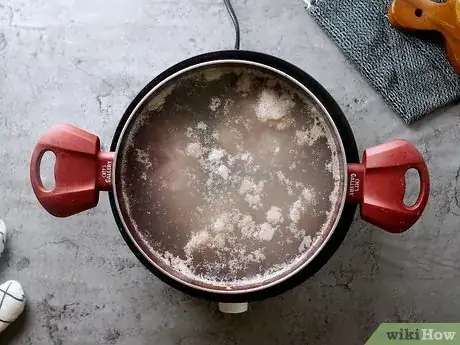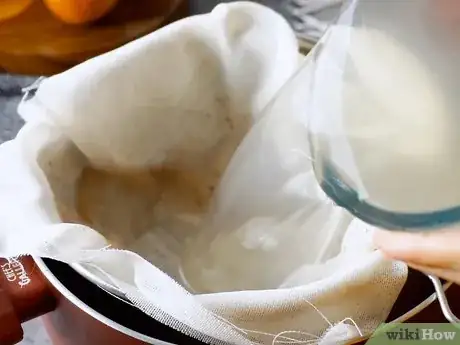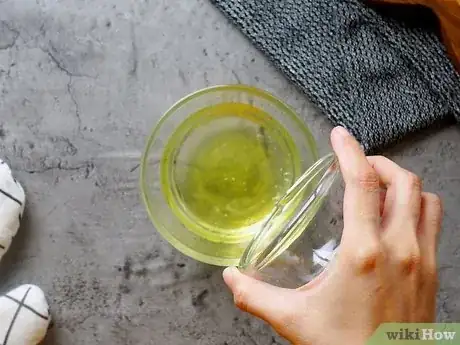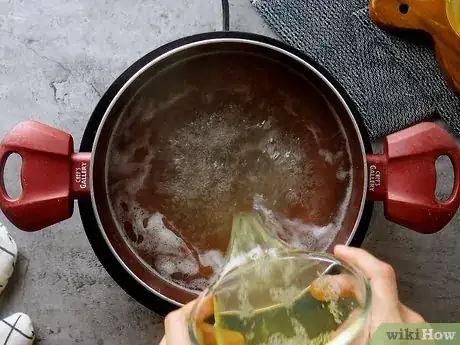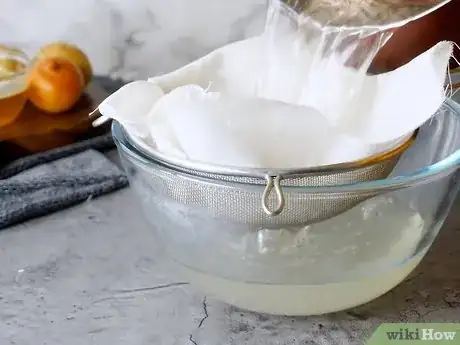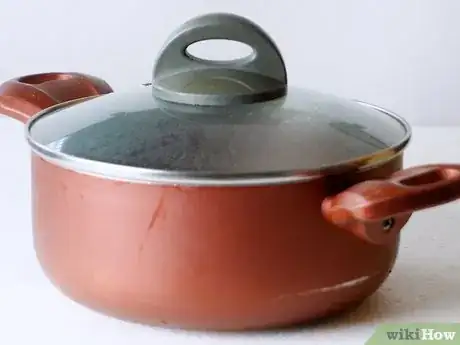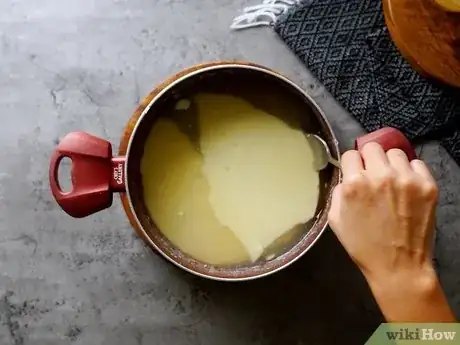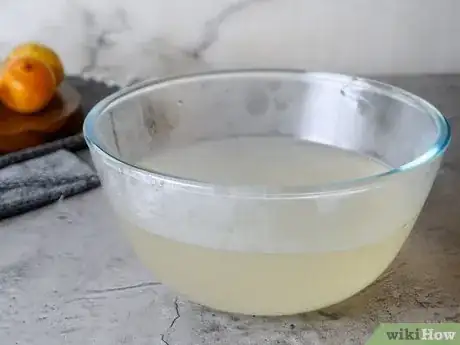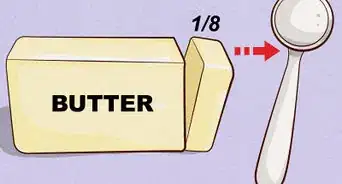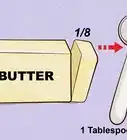This article was co-authored by wikiHow Staff. Our trained team of editors and researchers validate articles for accuracy and comprehensiveness. wikiHow's Content Management Team carefully monitors the work from our editorial staff to ensure that each article is backed by trusted research and meets our high quality standards.
There are 11 references cited in this article, which can be found at the bottom of the page.
The wikiHow Culinary Team also followed the article's instructions and verified that they work.
This article has been viewed 89,723 times.
Learn more...
Stock is the liquid that’s made from simmering animal bones over a long period of time.[1] Making stock at home is both nutritious and delicious. Stock can boost your immune system and improve your bone density.[2] However, when making stock, the fat typically emulsifies on the top and can leave a bad-tasting film in your mouth. Luckily, by following some simple techniques, you can remove the fat that rises to the surface of your stock by clarifying it.
Steps
Straining Your Stock
-
1Allow your stock to simmer until the soup’s fat floats to the surface. As you let your stock simmer, the fat will rise to the top creating a foamy buildup.
- If there is an excess of foam or fat buildup, you may have your heat turned too high. The stock needs to be slowly simmered over a long period of time, not boiled.
- Typical stocks should be simmered anywhere from 4 to 6 hours long.[3]
-
2Skim large portions of fat off with a spoon. You can do this while your stock simmers in multiple intervals to cut down on the amount of fat you will need to strain later on.[4]
- Stirring the fat into the stock will make it harder to remove later and give your stock a cloudy appearance.[5]
- You can do this with a wooden or heat-safe spoon.
Advertisement -
3Pour your stock through a large sieve or colander and cheesecloth. You can purchase a sieve or colander and cheesecloth at most grocery stores. Line the sieve with cheesecloth and drain your stock through it. This should separate the large pieces of bone and vegetables from the clear stock.
- Make sure to do this over the sink in case there is spillage.
- You can also use a colander instead of a sieve.
- Do not push down on the food at any time while you are draining it.[6]
- If you don’t have cheesecloth you can use a coffee filter.
-
4Drain your stock again, using a sieve and cheesecloth. Filter your stock again. This second filtering should remove most of the fat that remains in your stock.
Using Egg Whites to Clarify Stock
-
1Run your stock through a colander and cheesecloth. Before you use the egg white method, you need to ensure that you first remove the large chunks of food. Put cheesecloth over the surface of your colander or sieve and drain it.[7]
-
2Stir ¼ cup of cold water and egg whites in a bowl. Use two eggs and separate your egg whites into a bowl and beat them. Once you are done with that, stir in ¼ cups of cold water. The egg whites will bind any remaining particles, which will enable you to achieve a clearer stock.[8]
- Read Separate-an-Egg if you don’t know how to separate egg whites from the yolk.
-
3Bring the stock to a boil and stir in the egg white and water mixture. Once the stock is back to a rolling boil, pour in your egg white and water mixture into the pot.
- A rolling boil is achieved when bubbles are rapidly breaking the surface of the water. You should not be able to break the boil by using a spoon to stir your stock.[9]
-
4Remove the pot from heat and let sit for 5 minutes. All of the fat in your stock should bind to the egg whites while you let it sit. Let the stock sit at room temperature.
- You should see your egg whites rise to the top and coagulate on the surface of your stock.[10]
-
5Strain stock through sieve and cheesecloth. Once all the fat has collected onto the egg whites, do a final straining through a sieve and cheesecloth. Your large clump of egg whites and fat should be caught in the cheesecloth, leaving you with a clear and clarified stock.
Chilling Your Stock to Clarify it
-
1Strain your stock through a sieve lined with cheesecloth. Straining your stock is important in all methods of clarification.
-
2Chill your stock in a bed of ice. Sticking your stock into the refrigerator or freezer could potentially create bacteria. Instead, fill a bowl or your sink up with ice cubes, and place your pot, with the lid into the bed of ice. Stir the stock every 2-3 minutes until it is chilled.
- Food that stays at 40°F(4°C) to 140°F(60° C) for more than two hours could be potentially dangerous to eat.[11]
-
3Place into the refrigerator until the fat hardens. Leaving your stock in the refrigerator for a couple of hours, or overnight, will allow all the excess fat to rise to the top and harden.[12]
- There should be a thick layer of fat on the surface of your stock, even if you’ve already strained it.
-
4Peel the top layer of fat off your stock carefully. You can use a spoon or other utensil to carefully peel away the top layer of hardened fat. After you are done, you should be left with a flavorful, clear stock.[13]
- You can use the leftover fat as lard in other recipes.
-
5Finished.
References
- ↑ https://www.thekitchn.com/whats-the-difference-between-stock-and-broth-word-of-mouth-71199
- ↑ http://www.kitchenstewardship.com/2013/02/21/10-reasons-i-drink-bone-broth/
- ↑ http://ruhlman.com/2011/08/stock-clarifications/
- ↑ http://www.asageamalgam.com/2012/01/chicken-stock-clarified/
- ↑ http://www.epicurious.com/recipes/food/views/chicken-stock-108211
- ↑ http://www.asageamalgam.com/2012/01/chicken-stock-clarified/
- ↑ https://localkitchenblog.com/2009/04/22/how-to-clarify-cloudy-chicken-stock/
- ↑ http://www.asageamalgam.com/2012/01/chicken-stock-clarified/
- ↑ http://www.wisegeek.org/what-is-a-rolling-boil.htm
About This Article
If you’re making your own bone or vegetable stock, you can remove the fat that rises to the surface by clarifying it. Some methods of doing this are: straining your stock, clarifying with egg whites, or chilling your stock. To clarify your stock by straining it, first allow your stock to simmer until the soup’s fat floats to the surface. Typical stocks should be simmered anywhere from 4 to 6 hours. As your stock simmers, skim the fat that rises to the surface in regular intervals. You can do this with a wooden or heat-safe spoon. Once your stock is cooked, pour it through a large sieve to separate the large pieces of bone or vegetables from the clear stock. If you do not have a sieve, you can use a colander and cheesecloth. Filter your stock a second time to remove any leftover fats and clarify it. To clarify your stock using the egg white method, run your stock through a colander and cheesecloth after it is cooked. Then, mix 1/4 cup of cold water and 2 egg whites in a bowl. The egg whites will bind to any remaining particles, and leave a clearer stock. Bring your cooked and strained stock back to a boil and stir in the egg white and water mixture. Next, remove the pot from the heat and let it sit for 5 minutes to allow the fats to bind to the egg whites. Lastly, do a final straining through a sieve and cheesecloth. To clarify your stock by chilling it, first strain your stock through a sieve lined with cheesecloth. Then, fill a large bowl with ice cubes, and place your pot, with the lid on, into the bed of ice. If you do not have a bowl larger than your pot, you can fill your sink with ice instead. Stir the stock every 2-3 minutes until it is completely chilled. Transfer your stock to the refrigerator and leave it for a couple of hours, or overnight. The fat will harden and leave a thick layer of fat on the surface of your stock. Carefully peel off the top layer of fat and enjoy your clarified stock!
